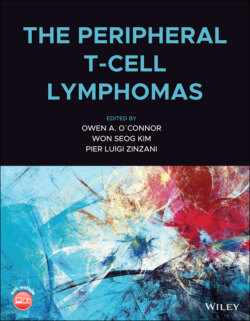Читать книгу The Peripheral T-Cell Lymphomas - Группа авторов - Страница 55
Intestinal T‐cell Lymphoma
ОглавлениеThese rare lymphomas are derived from intestinal intraepithelial lymphocytes and express the mucosal homing receptor CD103. There are at least three clinical pathologic variants. The two aggressive variants are now called enteropathy‐associated and monomorphic epitheliotropic intestinal TCL. The third subtype, indolent T‐cell lymphoproliferative disorder of the gastrointestinal tract has a more indolent course [76]. The majority of cases are of the γδ subtype, while about one‐third of cases have the STAT5B mutation similar to hepatosplenic TCL (HSCTL). The Janus‐associated kinase/ signal transducers and activators of transcription (JAK/STAT) pathway is the most frequently mutated pathway with frequent mutations in STAT5, JAK1, JAK2, STAT3, and SOC1, as well as less common mutations in KRAS, TP53, TERT11.
SETD2 is the most frequently mutated gene in enteropathy‐associated TCL (32% of cases) [60]. The SETD2 gene encodes a histone methyltransferase that is specific for lysine‐36 of H3, which has been associated with transcriptional activation. SET domain containing 2 (SETD2) is an enzyme that in humans is encoded by the SETD2 gene. SETD2 protein is a histone methyltransferase that is specific for lysine‐36 of histone H3, and methylation of this residue is associated with active chromatin. This protein also contains a novel transcriptional activation domain and has been found associated with hyperphosphorylated RNA polymerase II. The trimethylation of lysine‐36 of histone H3 is required in human cells for homologous recombinational repair and genome stability. Depletion of SETD2 increases the frequency of deletion mutations that arise by the alternative DNA repair process of microhomology‐mediated end joining [77]. While SETD2 is mutated in about one‐third of TCL cases, it is likely to be identified in other subtypes of PTCL.
